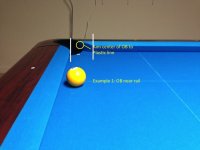Without this understanding there's a disconnection in the players experience of the g
Playing pool creates a deep satisfaction when we allow the game to express it's self. For this to happen we strive to connect ourselves to what the cue ball is really doing and make it conform to what we "think".
The TOI technique "stirs this reality up" by seeking to control something that is naturally happening (deflection) and allows us to be on the same team, instead of in conflict. Without this relationship it's very difficult (if not impossible) to relate to what a "Pocket Zone" really is. Favoring the Inside part of the cue ball will encourage this to start happening naturally.
Once we get on this track the next step is connecting the sensation of hitting the cue ball to the sensation of hitting the center of the pocket. This is the process we all must go through, either consciously or unconsciously to have the ability to hit any "part" of the pocket.
The object ball is not the "target", it's a "liaison" between the cue ball and the pocket. We don't have any physical contact with the object ball, it's the cue ball that we are influencing directly and the target is the pocket.
Without this understanding there's a disconnection in the players experience of the game and in many cases they will never know why. 'The Game is the Teacher'
Funny that you should open up a thread on this for I have just discovered it myself a few months ago and have been enjoying pool even more. Now on my Gandy table I aim at the actual points of the cushion either the left or the right point depending on where I am shooting from but on a Gold Crown table I have to change that to the "Plastic Point" on either the left or right side which is deeper in the pocket. Now to have even more fun CJ Wiley's TOI (Touch of Inside) has helped me become even more accurate in just the few days that I have been using it aiming at the same point. Now I have added my own "TOO" (Touch of Outside) when I need to aim at the left or inside cushion point. Just a side note I have looked at Tor Lowery's Zero-x video on youtube the part on staying on the correct side of the OB and reviewed some fundamentals and all I have to say is if I have anymore fun at the table they are going to call the police and have me arrested. Great post!!!
Playing pool creates a deep satisfaction when we allow the game to express it's self. For this to happen we strive to connect ourselves to what the cue ball is really doing and make it conform to what we "think".
The TOI technique "stirs this reality up" by seeking to control something that is naturally happening (deflection) and allows us to be on the same team, instead of in conflict. Without this relationship it's very difficult (if not impossible) to relate to what a "Pocket Zone" really is. Favoring the Inside part of the cue ball will encourage this to start happening naturally.
Once we get on this track the next step is connecting the sensation of hitting the cue ball to the sensation of hitting the center of the pocket. This is the process we all must go through, either consciously or unconsciously to have the ability to hit any "part" of the pocket.
The object ball is not the "target", it's a "liaison" between the cue ball and the pocket. We don't have any physical contact with the object ball, it's the cue ball that we are influencing directly and the target is the pocket.
Without this understanding there's a disconnection in the players experience of the game and in many cases they will never know why. 'The Game is the Teacher'
